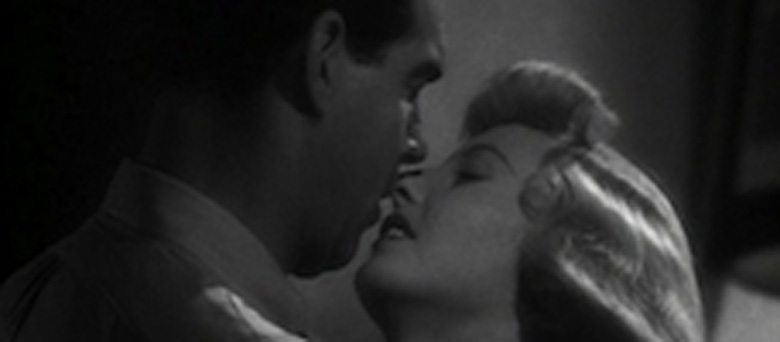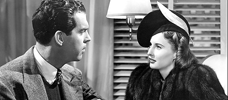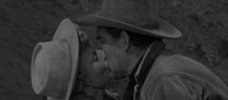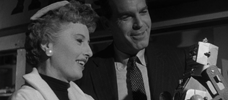Reviews
Billy Wilder
USA, 1944
Credits
Review by Leo Goldsmith
Posted on 14 April 2010
Source Universal Home Entertainment DVD
Categories A Criminal Couple
A woman is a funny animal.
—James M. Cain, Double Indemnity
As any contemporary pundit will tell you, it is no small task to make the subject of insurance sound sexy, much less malevolent, perilous, or ripe for abuse by those with weak morals and wicked minds. One small measure of James M. Cain’s literary greatness lies in his deft appropriation of an otherwise innocuous bit of insurance jargon - “double indemnity” - as a way of connoting a host of hidden agendas. Cain was himself an insurance salesman early in his career, but it was his ear for language and his nose for perversity that drew him to the darker import of the phrase. The slightly mysterious word “indemnity,” which literally means “protection from loss, liability, or penalty,” also shares a Latin root with the words “damn” and “damage”: it is a kind of exoneration, an absolution. And then there is the “double,” which denotes the doubling of the payout from an insurance claim - say, for an accidentally-on-purpose fall from a moving train - but more pointedly, the underlying duplicity that such a claim might entail: double meanings, and double-crosses.
There are many such doubles in Cain’s novel and in Billy Wilder’s adaptation of it—indeed the twin iterations of this dark tale of insurance fraud are themselves partners in crime, reflecting the concurrent development of pulp fiction and film noir in the 1930s and 40s, the ways in which each medium influenced and amplified the imagery and immorality of the other. Double Indemnity offers a juicy specimen, not only as a fusing of the sensibilities of two literary giants - Cain and Raymond Chandler - with that of Wilder, by then a formidable craftsman of cinematic narrative, but also as the quintessential articulation of the relationship between men and women in the noir universe. Phyllis Dietrichson and Walter Neff - Phyllis Nirdlinger and Walter Huff in Cain’s original - are archetypes of a genre built around desire and distrust between the sexes, a genre of fallen women and faltering men in a dark and unforgiving world.
What Wilder seems to have extrapolated from Cain’s novel is the sense that the anti-hero and -heroine are bound to each other: they manipulate and deceive and even hate each other, but they are also inextricable in their mutual enmity and the darkness of their desires. As Phyllis says in the film, they are both rotten, and like all men and women in the noir worldview, this shared rottenness both separates and links them. As Phyllis and Walter, Barbara Stanwyck and Fred MacMurray make for a canny, if rather unusual duo that succinctly captures the complexity of such gender relations, their awkwardness and irrevocability. Vampish and platinum blonde, with carefully lacquered makeup and outfits by Edith Head, Phyllis seems a prototype of the femme fatale: showy and cunning, if a little rough around the edges. But she is also small and somewhat unthreatening, especially next to the boxy MacMurray, who is less the square-jawed hero type than a slightly flabby everyman, an average joe with a smart mouth and a jaundiced eye.
Wilder immediately announces his dim view of masculinity in the film’s opening titles with the menacing silhouette of a man on crutches. More doubling: this could be the ill-fated Mr. Nirdlinger, or it could be Walter playing his stand-in, but either way the man is weak, wounded, and nearer to death than he knows. Walter at least has some idea of what’s in store for him. “It was the walk of a dead man,” he presages upon completing his crime, and he later takes to heart the comment by his friend and boss Keyes, Edward G. Robinson’s claims adjuster, that two co-conspirators in a crime are on “a trolley car they must ride to the end of the line, and the last stop is the cemetery.” This metaphor of the unswerving fates of train travel is consistent throughout the film: Walter’s weakness is his lack of free will, his utter compulsion to accompany Phyllis “straight down the line.” And from the first scene of the film, the greater part of this compulsion is explicitly illustrated as sexual, as he suggests in his voiceover account after his second encounter with Phyllis: “I was all twisted up inside, and I was still holding onto that red-hot poker.” He gets a cold beer at a drive-in and “roll[s] a few lines” (i.e. goes bowling), but it’s no use, and soon he is in her clutches: “I’m crazy about you, baby.”
The classical noir structure of the noir is that of a first-person recollection of events, a retrospective recounting of a linear unfolding of events, actions, and emotions. As in Double Indemnity, there is a strong sense of confession and apology - in the film, through the medium of the Dictaphone; in the novel, as a written confession - as if to say, “This is how things happened; this is how I fell in love with that dame; this is why I did what I did.” Of course, in both Cain’s novel and Chandler and Wilder’s script, this narration benefits a distinctly male point-of-view in opposition to a female one: we are focalized entirely through Walter’s eyes, we know only what he knows. Both novel and film also add to this sense of masculine identification with the character of Keyes, the shrewd claims adjustor who Walter clearly likes and respects. (Their relationship is more fully developed in the film, with Walter sarcastically telling him, “I love you, too,” and lighting his cigars for him by striking matches off his thumbnails.)
Both the literary and the cinematic Double Indemnities are structured around the dominant narration of the victimized male, but Wilder has an advantage: Barbara Stanwyck. Her presence onscreen is another suggestion of the dialogue between the pulp crime novel and the film noir the way they feed off and reflect one another. While Cain’s novel, by necessity, must suppress Phyllis’s intricacies until the final twists are revealed, Wilder’s film gets to revel in Stanwyck’s physical aura all along, offering a bodily counter-narrative to an otherwise male-centric oral account about the temptations and pitfalls of a rapacious femininity. Always a versatile actor, equally capable of playing party girls and strong-willed women, Stanwyck introduces the right amount of emotional complexity into a narrative that could easily have stayed locked in the linear death-ride of a self-pitying, self-destructive male narrator. Double Indemnity thus becomes her story, too: an erotic descent into mutual masochism, straight down the line.
More A Criminal Couple
We don’t do comments anymore, but you may contact us here or find us on Twitter or Facebook.







